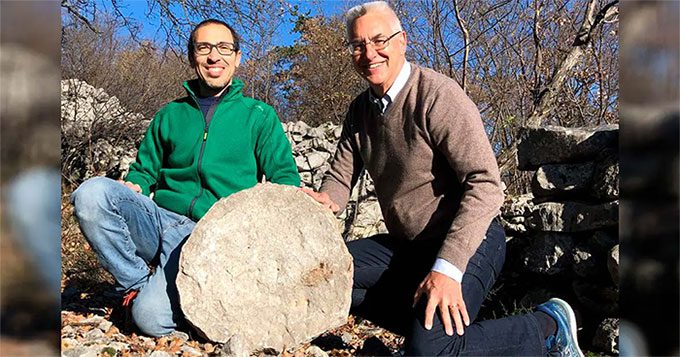2,500 years ago, at an abandoned ancient fortress in Italy, someone left behind a priceless and mysterious treasure for modern archaeologists.
According to Ancient Origins, the treasure features an “irrational double occurrence” and was discovered in the village of Rupinpiccolo, located in the province of Trieste, in the Friuli-Venezia Giulia region of Italy.
This village once housed a fortified structure built between 1800-1650 BC, during the Middle Bronze Age in the area.

Archaeologist Federico Bernardini and astronomer Paolo Molaro at the Rupinpiccolo fortress with the treasure they discovered – (Photo: INAF)
Since the 5th century BC, approximately 2,600 years ago, the Rupinpiccolo fortress has been abandoned.
The treasure recently announced by the Italian National Institute of Astrophysics (INAF) consists of two mysterious circular stones found in the area of the ancient fortress.
One stone symbolizes the Sun, while the other stone represents a celestial map.
The dating results are perplexing: They were carved around the 4th century BC, approximately 2,500 years ago.
This was a century after the fortress had been abandoned. Therefore, it remains unknown who carved them and why they left this pair of circular stones during that era.
The sun symbol, alongside the celestial map, hints at a vague suggestion of the heliocentric theory, even though it does not accurately represent the understanding that the Sun is the center of its planets, rather than other celestial bodies.
The first modern form of the heliocentric theory was proposed by the astronomer Nicolas Copernicus, who lived in the 15th century AD.
29 individual carvings on the stone that resembles a cosmic map depict selectively carved celestial bodies, including the constellations Scorpius, Libra, Virgo, and the Pleiades cluster (also known as the Seven Sisters).
Another star, not present today but suspected to be Theta Scorpii, could have been observed from the hill where the fortress is located around 400 BC and earlier.
The discrepancies with today’s cosmic map allow scientists to identify a supernova, which may have turned into a black hole in the sky. If the black hole from Theta Scorpii is found, the hypothesis that the stone is a celestial map will be further validated.
Although it remains controversial due to missing some prominent stars from the sky, scientists argue that the carved stars were chosen with a specific intent, rather than depicting the entire sky.
Analytical results also show that the carvings were made using hammers and chisels. However, the biggest mystery remains who created them and for what purpose.
This 2,500-year-old treasure is still under further study. If all the aforementioned hypotheses are confirmed, its value will be elevated as it could become the oldest celestial map ever discovered in the world, representing knowledge that is “timeless.”


















































